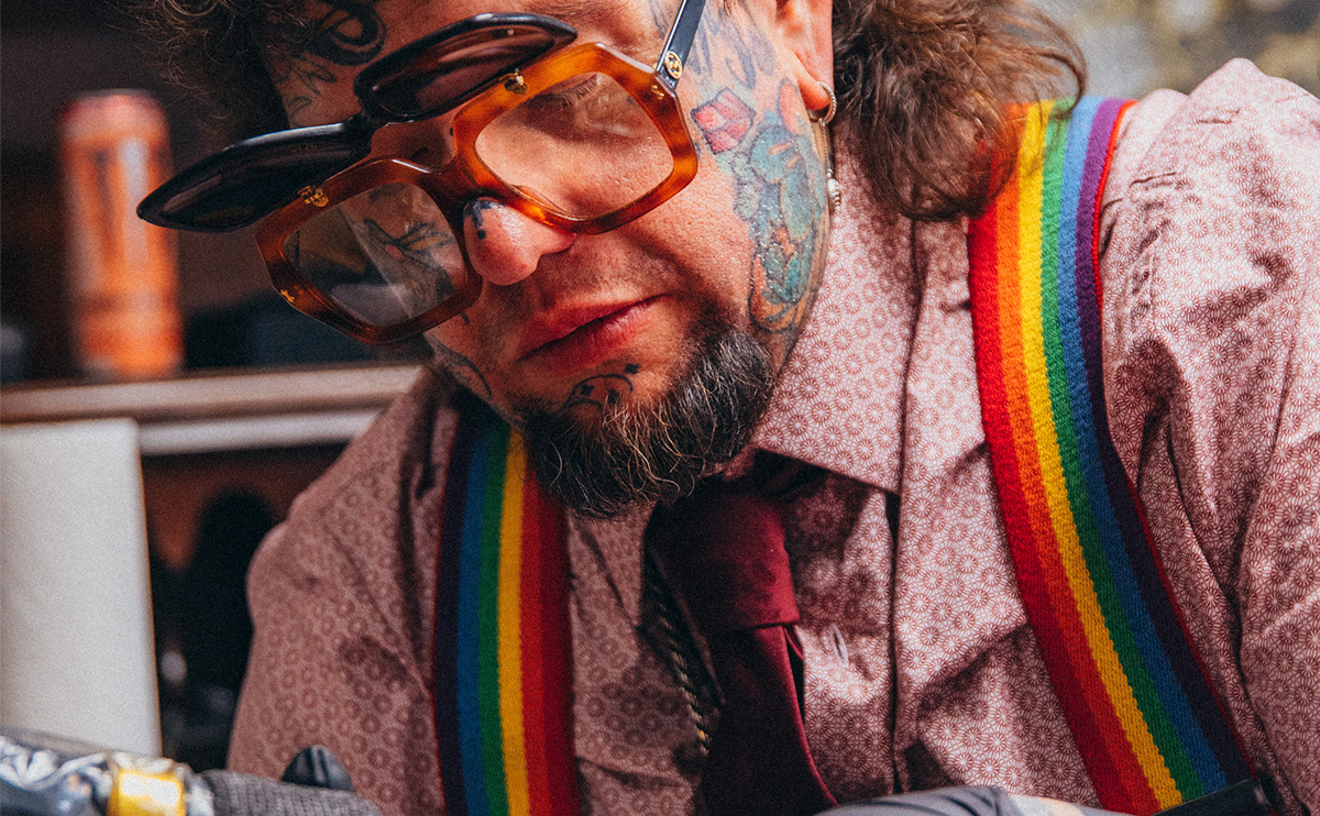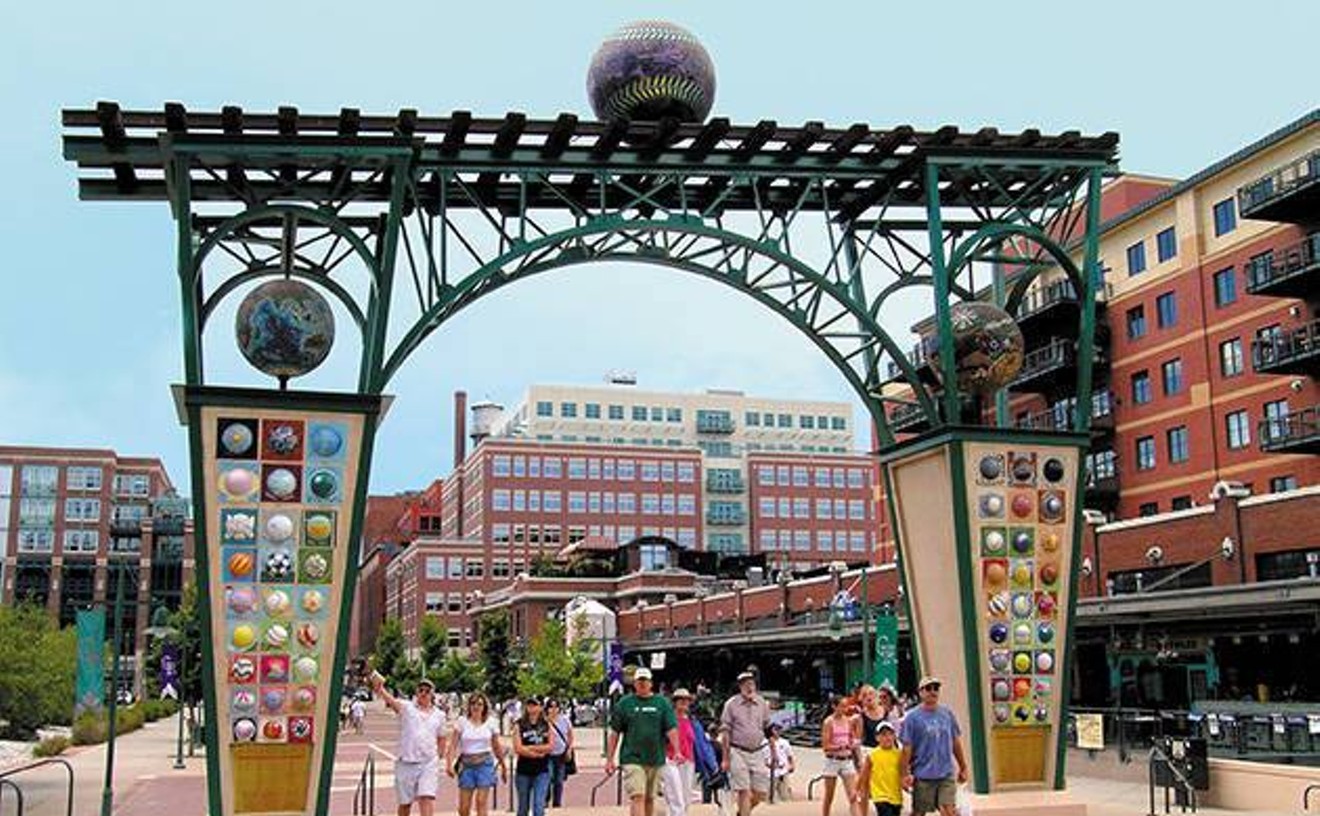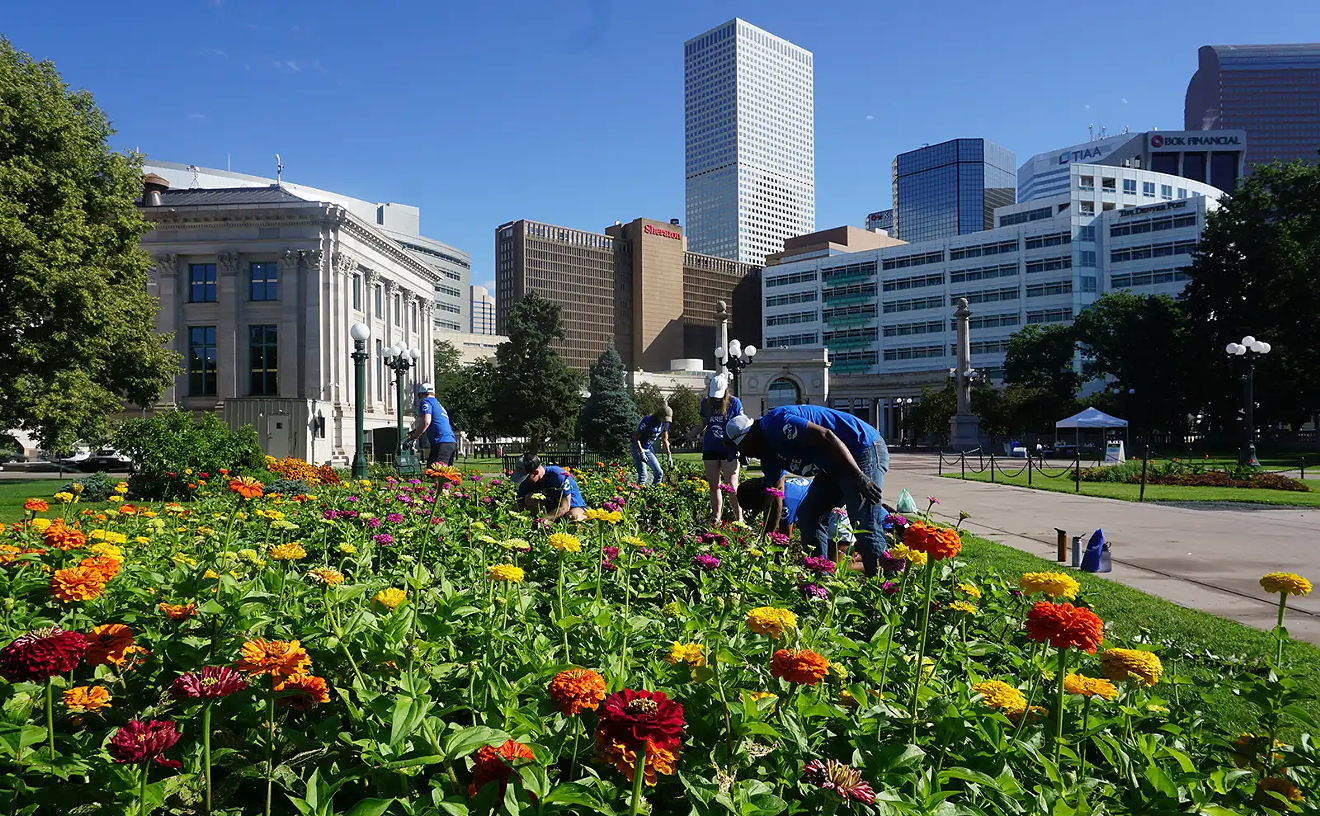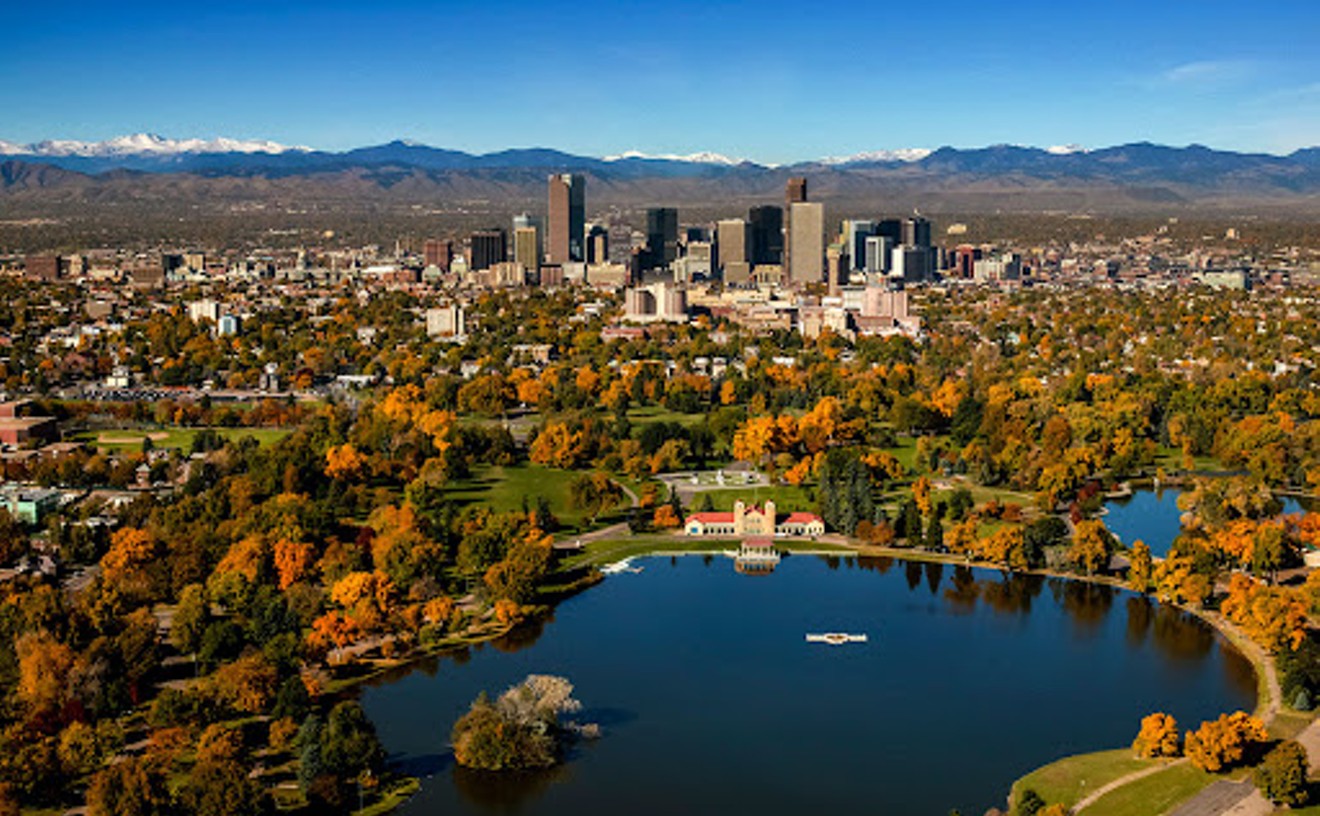Fresh Eyes begins with a section filled with the gelatin silver print photographs by Denver's Mark Sink. For those who may have not followed Sink's career carefully enough -- and apparently I haven't -- these photos are a major surprise. When I think of Sink's photos, I think of flowers and gauze and, of course, the bare breasts of young women. I don't think of reverse silhouettes of bottles and glasses, but those are the subjects he has chosen here, placed on saturated black grounds. The margins of the glassware are filled in with fuzzy gray details, an effect Sink achieved by simply laying a bottle or glass on photographic paper and exposing it to a flick of light.
Next up is a group of David Sharpe silver print enlargements based on pinhole photographs used in lieu of negatives. Sharpe, who lives in Denver, has done photos of this sort for many years, using pinhole cameras made from oatmeal boxes and tea cans. The results are blurry shots of outdoor scenes carried out in a monumental photo-mural format. All of them have been directly adhered to the wall, and the edges have been allowed to curl down, which enhances the primitive, out-of-focus character of the pinhole originals. Every one of these photos has been well conceived, and some are tremendous, such as the lyrical and impressionistic "Aspens north of Mt. Princeton" and "Nest in Tree."
Further on are a good many color-copier Type C prints by Denver's Scott Engel. The prints, from his abstract "Decompose" series, were produced by composting printed materials such as magazines and catalogues. Engel periodically scrapes away the layers and photographs whatever looks pleasing to him, then prints them using a color copier. Especially nice is his palette, partly the product of the tones limited by the color-copier technique, and partly the result of the original printed sources fading through the rigors of composting.
The last part of the show is divided between some very elegant photos by Loveland's Michael Butts and photos and a photo-based installation by Derek Johnston from Basalt.
Butts's photos are gelatin silver prints of multiple-image landscapes that were originated from pinhole photographs. No explanation is given as to how Butts achieves his wavy and whirling effect, but I think he may move his pinhole camera while the lens is open. However he does it, though, it works, over and over again.
Johnston's platinum palladium print photos are of large glass jugs with photographic images of Western landscapes wrapping around the insides. The jugs, which originally held photo chemicals, have been filled with liquid -- presumably water -- making the photo image less distinct. In Johnston's large installation, the bottles themselves have been arranged on bottom-lighted glass shelves that make them glow. The photos are a lot better than the installation.
The other exhibit, Signs and Relics, is made up of some of the photos that appear in Plachy's new book. One of the most amazing features of this show is that the only thing that seems to connect the photos is the use of olive green mats on all of them. In this way, they seem like casually taken snapshots -- and that's exactly what they are.
Plachy, a longtime staff photographer for New York's Village Voice, is at her best with American subjects, which may be rooted in the fact that she was born in Hungary. Her European-based photos are bloodless and detached, while her depictions of Americans in bizarrely American situations -- a women's body-building competition or a little boy dressed as the devil sitting in a fast-food joint -- are loving and uncritical.
One of the biggest revelations in Signs and Relics is how the five local boys in Fresh Eyes compare when presented side by side with a big-name artist like Plachy. You know what? They look pretty darned good.
There's sad news coming out of the Boulder Museum of Contemporary Art: The institution has sold Harry Bertoia's "Sounding Sculpture I," one of the late artist's most important and largest tonal sculptures, and a piece that has been in Colorado since it was made in the early 1970s.
"Sounding Sculpture I" is constructed of metal rods topped by larger metal cylinders. The rods, mounted vertically in a dense rectilinear grid arranged on a flat horizontal base, are meant to move in the breeze and produce sounds reminiscent of the bells of an old grandfather clock.
It originally stood in Denver in front of the former Colorado National Bank, at 950 17th Street. That building, one of the finest formalist-style structures in the region, is a 1972 creation by world-renowned Japanese-American architect Minoru Yamasaki, who is best known as the architect of New York's World Trade Center towers. After the building's completion, the bank commissioned Bertoia to create "Sounding Sculpture I," and it was installed in front in 1976.
The decision to remove the sculpture in 1998 was just one of a number of bad things that began to happen at the bank in the late 1990s. First CNB was bought by Minneapolis-based US Bank, which immediately gathered up all the many important paintings and sculptures CNB owned and shipped them back to its Minnesota headquarters, robbing Denver of an important private resource. CNB had built its collection over the years, and it included the Bertoia as well as the separate Midland Federal Savings collection of regional art that CNB had acquired when it took over that institution in the late 1980s.
By the mid-1990s, problems had begun to appear in the dazzling white Vermont marble that covered the Yamasaki tower. It wasn't ready to come off, exactly, but it was beginning to fail because of spalling and flaking. This same problem is being seen around the world with other thin-cut stone panels that were hung on curtain walls in the 1970s and later.
In response, US Bank hired Fentress & Bradburn Associates to carry out the repairs. This was a mistake, as the firm's common touch noticeably diminished the building. Fentress & Bradburn convinced US Bank that the tower needed a total redo, and not only did it replace the cladding, but it destroyed the original features of the gorgeous main lobby and other handsome interior spaces. Instead of using the Vermont marble of the original -- which had been chosen to match the 1920s neo-classical Fisher and Fisher confection next door -- Fentress & Bradburn chose an undistinguished gray granite right out of Home Depot. The local yokels even altered the size of the panels and enlarged the mortar joints, as though Yamasaki hadn't already worked out the perfect formula for the stonework. As part of this redo, the decision was made to remove the Bertoia and give it to BMoCA, essentially as salvage.
By this point, the sculpture was already badly damaged, though. Over the years, people had grabbed the rods, pulling, pushing and bending them instead of waiting for a passing breeze to gently move them. At one time, CNB had tethered the top with chains to prevent the rods from coming too far out of line. But this tether was left off -- unwisely and against the advice of many (including myself) -- when "Sounding Sculpture I" was reinstalled at BMoCA. Even at the dedication in Boulder last fall, I watched as a locally famous painter, who will remain nameless, pushed one rod with all his might, against another. It had just been unveiled, and already it was being further damaged!
"When Bertoia made it, he could hardly have known that people would routinely damage public art," says Cydney Payton, BMoCA's director.
Last spring, when Clifford West, a friend of the late Bertoia, came to BMoCA to see the sculpture, it looked as though it had just barely survived a train wreck. West, horrified, contacted Norwegian art dealer Kaare Berntsen, a major collector and dealer of Bertoia's work. They made an offer for "Sounding Sculpture I" for an undisclosed amount (said to be somewhere around $125,000). This is very believable, since the sculpture's value, when restored, will be at least a quarter of a million dollars. Most of the proceeds from the sale will go toward BMoCA's endowment fund.
So here's the fly in the ointment: It turns out that the Vance Kirkland Foundation had been a runner-up when the bank was getting rid of the sculpture. According to Kirkland director Hugh Grant, the private foundation discovered too late that the Bertoia piece was up for grabs. So Grant is understandably upset that when BMoCA decided to sell it, the museum didn't contact him or make any attempt to place the sculpture with some other institution in Colorado. "BMoCA should be criticized for this," Grant says. "We would have loved to bring the sculpture back to Denver, where it should be."
Grant is right, but the real villains are US Bank, Fentress & Bradburn and, perhaps most of all, the city government, which could have stepped in at any time to save the sculpture, since everything the bank did required permits. Mayor Wellington Webb certainly used his bully pulpit on the naming of the new football stadium. Why didn't he speak up for the Bertoia?










